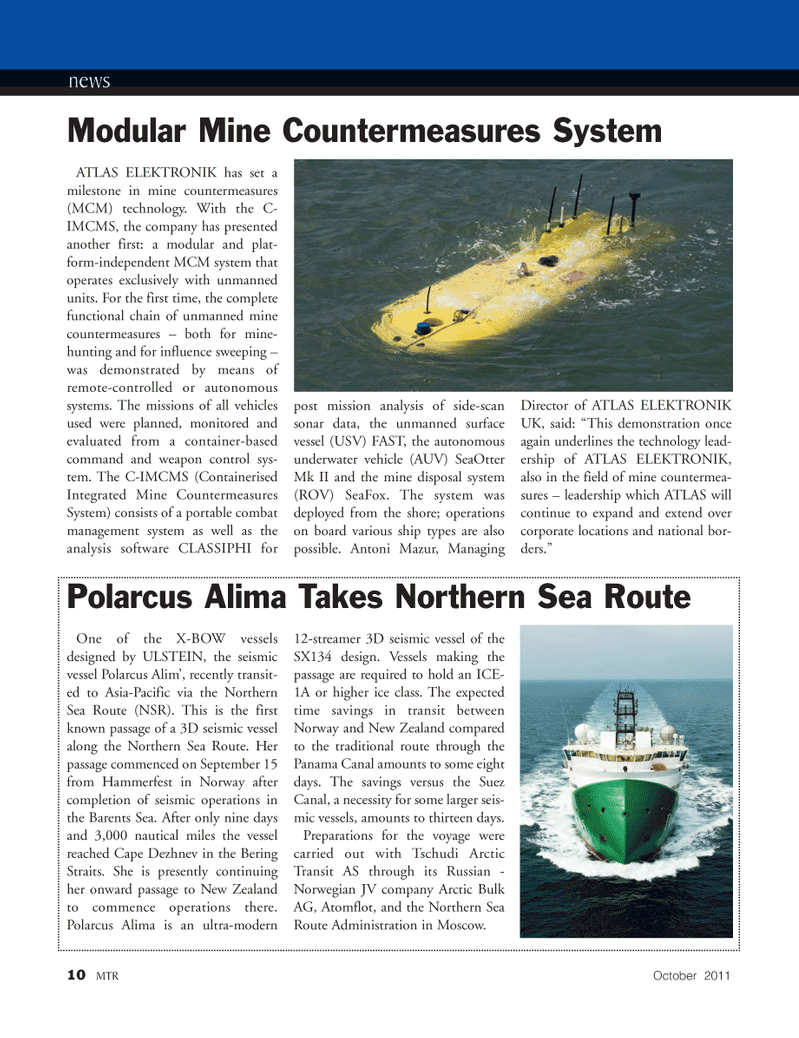
Page 10: of Marine Technology Magazine (October 2011)
Ocean Engineering & Design
Read this page in Pdf, Flash or Html5 edition of October 2011 Marine Technology Magazine
news 10MTROctober 2011ATLAS ELEKTRONIK has set a milestone in mine countermeasures (MCM) technology. With the C- IMCMS, the company has presented another first: a modular and plat-form-independent MCM system thatoperates exclusively with unmanned units. For the first time, the complete functional chain of unmanned minecountermeasures ? both for mine- hunting and for influence sweeping ? was demonstrated by means of remote-controlled or autonomous systems. The missions of all vehicles used were planned, monitored and evaluated from a container-based command and weapon control sys- tem. The C-IMCMS (Containerised Integrated Mine Countermeasures System) consists of a portable combat management system as well as the analysis software CLASSIPHI for post mission analysis of side-scansonar data, the unmanned surface vessel (USV) FAST, the autonomous underwater vehicle (AUV) SeaOtter Mk II and the mine disposal system(ROV) SeaFox. The system was deployed from the shore; operations on board various ship types are also possible. Antoni Mazur, Managing Director of ATLAS ELEKTRONIK UK, said: ?This demonstration once again underlines the technology lead-ership of ATLAS ELEKTRONIK, also in the field of mine countermea-sures ? leadership which ATLAS will continue to expand and extend over corporate locations and national bor-ders.?Modular Mine Countermeasures System One of the X-BOW vessels designed by ULSTEIN, the seismic vessel Polarcus Alim?, recently transit- ed to Asia-Pacific via the Northern Sea Route (NSR). This is the first known passage of a 3D seismic vessel along the Northern Sea Route. Her passage commenced on September 15 from Hammerfest in Norway after completion of seismic operations inthe Barents Sea. After only nine days and 3,000 nautical miles the vessel reached Cape Dezhnev in the Bering Straits. She is presently continuing her onward passage to New Zealand to commence operations there. Polarcus Alima is an ultra-modern 12-streamer 3D seismic vessel of the SX134 design. Vessels making the passage are required to hold an ICE- 1A or higher ice class. The expected time savings in transit between Norway and New Zealand compared to the traditional route through the Panama Canal amounts to some eight days. The savings versus the Suez Canal, a necessity for some larger seis-mic vessels, amounts to thirteen days. Preparations for the voyage were carried out with Tschudi Arctic Transit AS through its Russian - Norwegian JV company Arctic Bulk AG, Atomflot, and the Northern Sea Route Administration in Moscow. Polarcus Alima Takes Northern Sea Route MTR#8 (1-17):MTR Layouts 10/11/2011 9:46 AM Page 10

 9
9

 11
11
